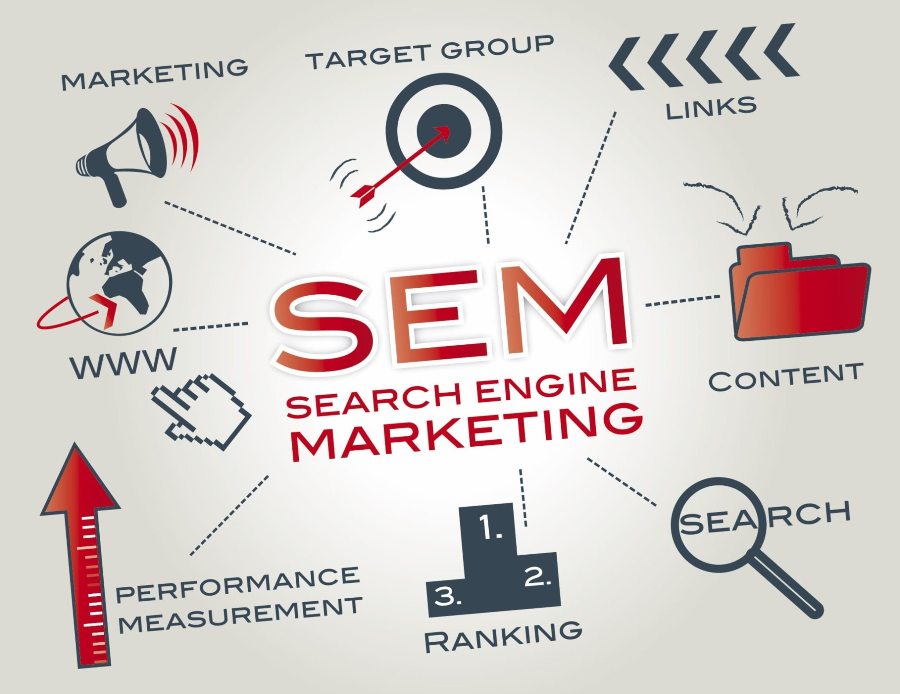The charm of 21st century is that we need to be as updated, modern and digital as we can. The process of search engine marketing or SEM also represents one of the best ways of modern marketing.
Search engine marketing is the practice of marketing a business using paid advertisements that appear on search engine results pages (or SERPs). Advertisers bid on keywords that users of services such as Google and Bing might enter when looking for certain products or services. It gives the advertiser the opportunity for their ads to appear alongside results for those search queries.
These ads, often known by the term pay-per-click ads, come in a variety of formats. Some are small, text-based ads, whereas others, such as product listing ads (PLAs, also known as Shopping ads) are more visual, product-based advertisements that allow consumers to see important information at-a-glance, such as price and reviews.
Search engine marketing’s greatest strength is that it offers advertisers the opportunity to put their ads in front of motivated customers who are ready to buy at the precise moment they are ready to make a purchase. No other advertising medium can do this, which is why search engine marketing is so effective and such an amazingly powerful way to grow your business.
Defining SEM in Easy English
Search engine marketing (SEM) is a method of promotion and advertising to help companies’ content rank higher among search engine traffic. Like search engine optimization (SEO), search engine marketing helps companies improve the way content is ranked by search engines.
How SEM works
- Conduct keyword research and select a set of keywords related to their website or product.
- Select a geographic location for the ad to be displayed within.
- Create a text-based ad to display in the search results.
- Bid on a price they are willing to pay for each click on their ad.
The Main Points that SEM Include are:
SEM focuses largely on using paid advertising to increase traffic through services such as Google ads or Bing ads. The following are key aspects of SEM: It is based on keyword analysis. Marketing departments identify keyword terms that might draw users to a webpage.
The Most Popular Types of SEM are:
- Pay per Click (PPC)
- Local SEO.
- Organic SEO.
Advantages and Disadvantages of SEM
Undoubtedly, search engine marketing is a powerful tool for almost all types of brands. Let us examine some advantages and disadvantages to evaluate when and how to use SEM.
Advantages:
- Highly measurable:
SEM campaigns are very measurable; with tools like Google Ads, you can track your results and see how your investment is performing.
- Real-time monitoring:
You can monitor your SEM campaigns in real-time to see how everything is progressing and make changes as needed.
- Pay per click:
You only pay for the results. You can control the maximum daily budget you are willing to invest and the maximum cost per click and make sure you’re not wasting money.
- Speed:
SEM campaigns can be set up quickly and start delivering results in a matter of days or weeks.
- Within everyone’s reach:
A SEM campaign’s budgetary investment is scalable, so it works for large companies and SMEs. They all compete in equal conditions to reach the first positions for keywords.
- Targeting:
You can target your SEM campaigns to specific demographics, interests, and past behavior.
Disadvantages
- Cost:
SEM can have a higher long-term cost since it works as long as you pay. Although, over time, you can optimize your campaigns and reduce costs per click.
- Competition:
There is a lot of competition for SEM keywords, so you may have to pay more to get your ad seen. This competition causes costs to rise, and sometimes it can be difficult to get a good ROI.
- Ad Blockers:
Some people use ad blockers, which can prevent your ads from being seen.
- Interruptive:
Some people find SEM ads to be intrusive.
Is SEO or SEM profitable for quick leads?
SEO and SEM work best in complementary roles. SEO is the long-term powerhouse, SEM the short term testing ground and impression magnifier. Executing on both, and utilizing the data from each campaign to help the other, is one of the most beneficial strategies in all of digital marketing.
What is the purpose of SEM and goal of search engine marketing?
SEM is a digital marketing strategy used to increase your site’s visibility in search results. This can include both paid and organic (SEO) efforts. While SEM broadly covers more than just paid marketing, it’s often also referred to as pay-per-click (PPC) marketing.
Conclusion
I hope, the things that have been discussed in this article will support you. It will build up your confidence to progress in the field of SEM or search engine marketing.
It aids in attracting a mobile audience. If your target audience is looking for a company similar to yours on the go and if you are running search engine advertisements, they will likely discover you. Maintaining your presence within the smartphone market is important as more people use mobile devices.
SEM is essential because it ensures that your target audience sees the content you create in their search query results. You’re not left competing for organic space, as your advertisements are shown at the top of the first SERP page. You can effectively reach your target audience, drive traffic, and boost conversions.
So, be confident and courageous enough to be a part of SEM.
Best of luck!


Hey, Jack here. I’m hooked on your website’s content – it’s informative, engaging, and always up-to-date. Thanks for setting the bar high!